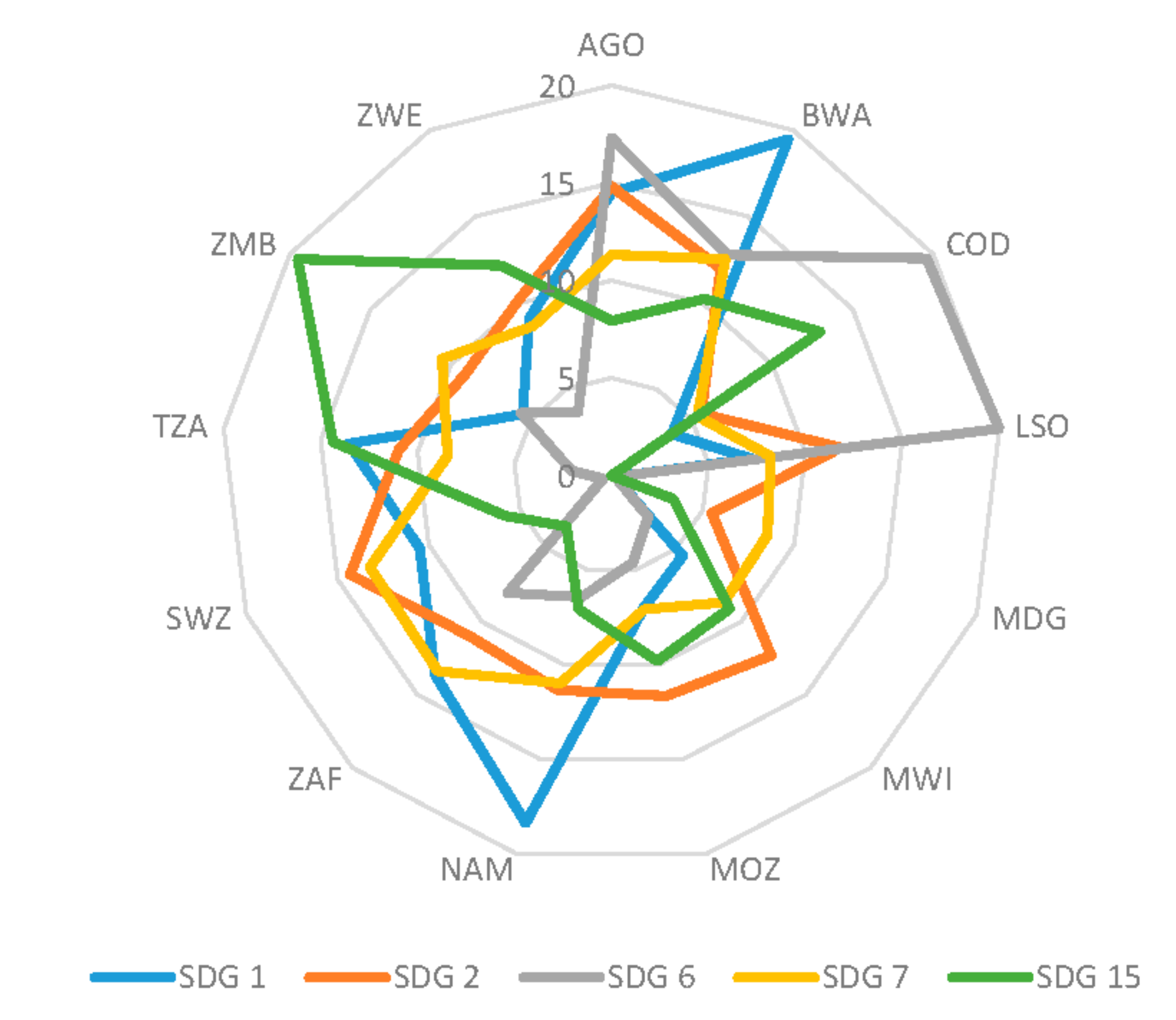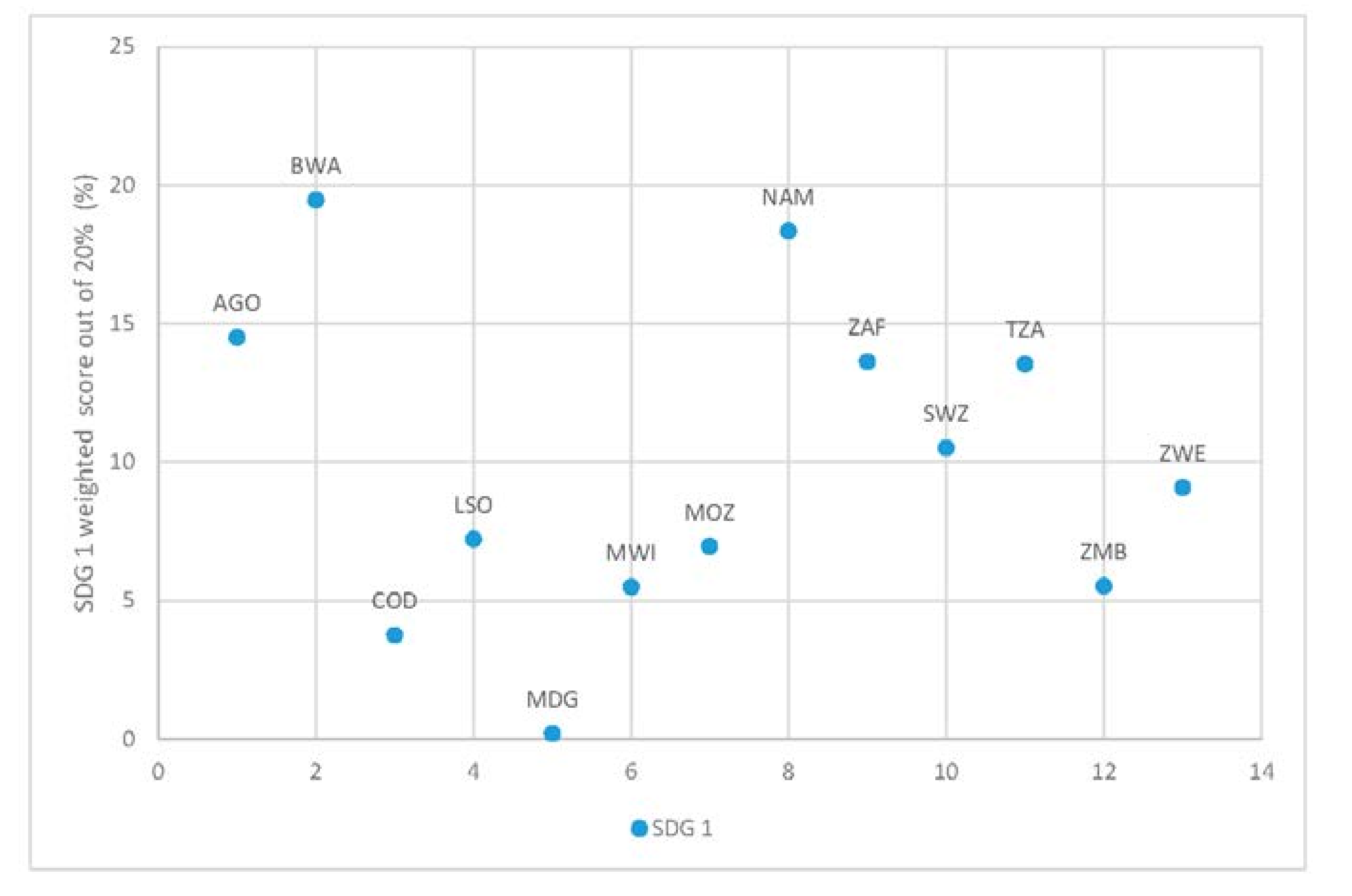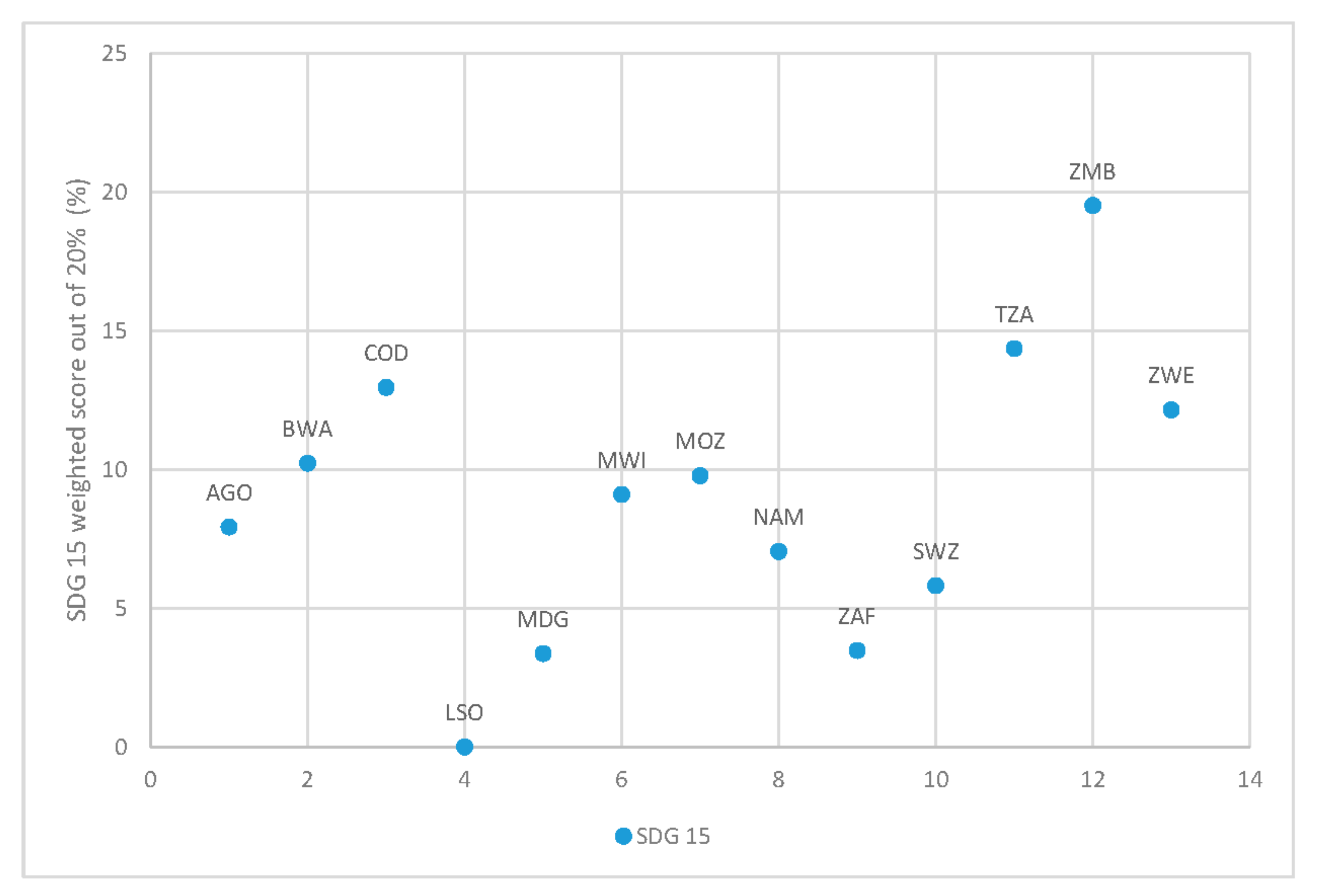Measuring Baseline Agriculture-Related Sustainable Development Goals Index for Southern Africa
Abstract
:1. Introduction
2. Review of Literature
2.1. Agriculture-Related SDG Indicators in the SDG Framework and Selection of Indicators
2.2. Importance of Agriculture in Contributing to Sustainable Development in Southern Africa
3. Materials and Methods
3.1. Overview of Application of Composite Indicators/Indices
3.2. Indicator Selection and Data Used for Empirical Analyses
3.3. Methodology for Computing the Baseline Agriculture-Related SDG Index
3.3.1. Normalization and Weighting of Indicators
3.3.2. Calculation of the Baseline Agriculture-Related SDG Index
3.3.3. Aggregation
3.3.4. Robustness and Sensitivity Analysis
4. Results and Discussion
5. Conclusions
Acknowledgments
Author Contributions
Conflicts of Interest
References
- United Nations. Transforming our world: The 2030 agenda for sustainable development. In A/RES/70/1; United Nations: New York, NY, USA, 2015. [Google Scholar]
- Food and Agriculture Organization (FAO). Food and Agriculture: Key to Achieving the 2030 Agenda for Sustainable Development; Food and Agriculture Organization of the United Nations: Rome, Italy, 2016. [Google Scholar]
- Food and Agriculture Organization (FAO). Fao and the sdgs. In Indicators: Measuring Up to the 2030 Agenda for Sustainable Development; Food and Agriculture Organisation of the United Nations: Rome, Italy, 2017. [Google Scholar]
- Sustainable Development Solutions Network (SDSN). Solutions for sustainable agriculture and food systems. In Technical Report for the Post-2015 Development Agenda; Sustainable Development Solutions Network: Paris, France; New York, NY, USA, 2013. [Google Scholar]
- Food and Agriculture Organization (FAO). FAO and the 17 Sustainable Development Goals; Food and Agriculture Organisation of the United Nations: Rome, Italy, 2015. [Google Scholar]
- Anderson, W.; Johansen, C.; Siddique, K.H. Addressing the yield gap in rainfed crops: A review. Agron. Sustain. Dev. 2016, 36, 1–13. [Google Scholar] [CrossRef]
- Food and Agriculture Organization (FAO); Daugherty Water for Food Institute (DWFI). Yield gap analysis of field crops—methods and case studies. In FAO Water Reports No. 41; Sadras, V.O., Cassman, K.G.G., Grassini, P., Hall, A.J., Bastiaanssen, W.G.M., Laborte, A.G., Milne, A.E., Sileshi, G., Steduto, P., Eds.; Food and Agriculture Organization of the United Nations: Rome, Italy, 2015. [Google Scholar]
- Sustainable Development Solutions Network (SDSN). Getting Started with the Sustainable Development Goals: A Guide for Stakeholders; Sustainable Development Solutions Network: Paris, France; New York, NY, USA, 2015. [Google Scholar]
- Sustainable Development Solutions Network (SDSN). Indicators and a monitoring framework for the sustainable development goals: Launching a data revolution for the sdgs. In A Report to the Secretary-General of the United Nations by the Leadership Council of the Sustainable Development Solutions Network; Sustainable Development Solutions Network: Paris, France; New York, NY, USA, 2015. [Google Scholar]
- African Union Commission. Agenda 2063 “The Africa We Want”; African Union Commission: Addis Ababa, Ethiopia, 2015. [Google Scholar]
- African Union Commission. Agenda 2063 First Ten Year Implementation Plan 2014–2023; African Union Commission: Addis Ababa, Ethiopia, 2015. [Google Scholar]
- African Union Commission. Malabo Declaration on Accelerated Agricultural Growth and Transformation for Shared Prosperity and Improved Livelihoods; African Union Commission: Addis Ababa, Ethiopia, 2014. [Google Scholar]
- Southern Africa Development Community (SADC). Revised Regional Indicative Strategic; Development Plan 2015–2020; Southern Africa Development Community: Gaborone, Botswana, 2015. [Google Scholar]
- Southern Africa Development Community. Regional Agricultural Policy; Southern Africa Development Community: Gaborone, Botswana, 2014. [Google Scholar]
- Southern Africa Development Community. Outcomes of the Ministerial Workshop on Food Security and Poverty Reduction: Towards a Poverty Free and Food Secure Future; Southern Africa Development Community: Gaborone, Botswana, 2016. [Google Scholar]
- Nardo, M.; Saisana, M.; Saltelli, A.; Tarantola, S.; Hoffman, A.; Giovannini, E. Handbook on constructing composite indicators. In OECD Statistics Working Paper 2005/3; OECD Publishing: Paris, France, 2005. [Google Scholar]
- Saisana, M.; Tarantola, S. State-of-the-Art Report on Current Methodologies and Practices for Composite Indicator Development; European Commission, Joint Research Centre, Institute for the Protection and the Security of the Citizen, Technological and Economic Risk Management Unit: Ispra, Italy, 2002. [Google Scholar]
- Saltelli, A. Composite indicators between analysis and advocacy. Soc. Indic. Res. 2007, 81, 65–77. [Google Scholar] [CrossRef]
- Saisana, M.; Saltelli, A.; Tarantola, S. Uncertainty and sensitivity analysis techniques as tools for the quality assessment of composite indicators. J. R. Stat. Soc. Ser. A (Stat. Soc.) 2005, 168, 307–323. [Google Scholar] [CrossRef]
- Zhou, P.; Ang, B.; Poh, K. A mathematical programming approach to constructing composite indicators. Ecol. Econ. 2007, 62, 291–297. [Google Scholar] [CrossRef]
- Cherchye, L.; Moesen, W.; Rogge, N.; Van Puyenbroeck, T.; Saisana, M.; Saltelli, A.; Liska, R.; Tarantola, S. Creating composite indicators with dea and robustness analysis: The case of the technology achievement index. J. Oper. Res. Soc. 2008, 59, 239–251. [Google Scholar] [CrossRef]
- Hsu, A.; Esty, D.C.; Levy, M.A.; de Sherbinin, A. 2016 Environmental Performance Index; Yale University: New Haven, CT, USA, 2016. [Google Scholar]
- United Nations Development Programme (UNDP). Human development report 2016. In Human Development for Everyone; United Nations Development Programme: New York, NY, USA, 2016. [Google Scholar]
- Cherchye, L.; Moesen, W.; Rogge, N.; Van Puyenbroeck, T. An introduction to ‘benefit of the doubt’composite indicators. Soc. Indic. Res. 2007, 82, 111–145. [Google Scholar] [CrossRef]
- Inter-Agency and Expert Group on SDG Indicators (IAEG-SDGs). Tier Classification for Global SDG Indicators; Inter-agency and Expert Group on SDG Indicators (IAEG-SDGs): New York, NY, USA, 2017. [Google Scholar]
- Sachs, J.; Schmidt-Traub, G.; Kroll, C.; Durand-Delacre, D.; Teksoz, K. Sdg Index and Dashboards—Global Report; Bertelsmann Stiftung and Sustainable Development Solutions Network (SDSN): New York, NY, USA, 2016. [Google Scholar]
- Schmidt-Traub, G.; Kroll, C.; Teksoz, K.; Durand-Delacre, D.; Sachs, J.D. National baselines for the sustainable development goals assessed in the sdg index and dashboards. Nat. Geosci. 2017, 10, 547–555. [Google Scholar] [CrossRef]
- Kararach, G.; Nhamo, G.; Mubila, M.; Nhamo, S.; Nhemachena, C.; Babu, S. Reflections on the green growth index for developing countries: A focus of selected african countries. Dev. Policy Rev. 2018, 36, O432–O454. [Google Scholar] [CrossRef]
- Cornell University; INSEAD Business School; World Intellectual Property Organization (WIPO). The Global Innovation Index 2016: Winning with Global Innovation; Cornell University, INSEAD, and WIPO: Ithaca, NY, USA; Fontainebleau, France; Geneva, Switzerland, 2016. [Google Scholar]
- African Union Commission. Africa Regional Nutrition Strategy 2015–2025; African Union Commission: Addis Ababa, Ethiopia, 2015. [Google Scholar]
- Nhemachena, C.; Nhlengethwa, S.; Nhemachena, C. Exploring ways to increase public investments in agricultural water management and irrigation for improved agricultural productivity in Southern Africa. In Proceedings of the 2nd World Irrigation Forum (WIF2), Chiang Mai, Thailand, 6–8 November 2016. [Google Scholar]






| SDG | Description of the SDG and Linkage to Agriculture |
|---|---|
| SDG1: End poverty |
|
| SDG2 : Zero hunger |
|
| SDG6: Water |
|
| SDG7: Energy |
|
| SDG12: Sustainable consumption and production |
|
| SDG13: Combat climate change |
|
| SDG14: Oceans, Seas and Marine resources |
|
| SDG15: Life on land |
|
| Pros | Cons |
|---|---|
|
|
| SDG | Indicators Used for Agric.-Related SDG Index *,** |
|---|---|
| SDG1: End poverty |
|
| SDG2 : Zero hunger |
|
| SDG6: Water |
|
| SDG7: Energy |
|
| SDG12: Sustainable consumption and production |
|
| SDG13: Combat climate change |
|
| SDG14: Oceans, Seas and Marine resources |
|
| SDG15: Life on land |
|
| Country Name | Country Code | Score/100 Points | Rank/13 Countries |
|---|---|---|---|
| Botswana | BWA | 66, 97 | 1 |
| Angola | AGO | 65, 86 | 2 |
| Namibia | NAM | 54, 08 | 3 |
| Zambia | ZMB | 50, 33 | 4 |
| South Africa | ZAF | 49, 51 | 5 |
| Tanzania | TZA | 49, 40 | 6 |
| Lesotho | LSO | 47, 25 | 7 |
| Congo, Dem. Rep. | COD | 47, 24 | 8 |
| Swaziland | SWZ | 44, 33 | 9 |
| Zimbabwe | ZWE | 43, 78 | 10 |
| Mozambique | MOZ | 40, 01 | 11 |
| Malawi | MWI | 38, 42 | 12 |
| Madagascar | MDG | 17, 80 | 13 |
© 2018 by the authors. Licensee MDPI, Basel, Switzerland. This article is an open access article distributed under the terms and conditions of the Creative Commons Attribution (CC BY) license (http://creativecommons.org/licenses/by/4.0/).
Share and Cite
Nhemachena, C.; Matchaya, G.; Nhemachena, C.R.; Karuaihe, S.; Muchara, B.; Nhlengethwa, S. Measuring Baseline Agriculture-Related Sustainable Development Goals Index for Southern Africa. Sustainability 2018, 10, 849. https://0-doi-org.brum.beds.ac.uk/10.3390/su10030849
Nhemachena C, Matchaya G, Nhemachena CR, Karuaihe S, Muchara B, Nhlengethwa S. Measuring Baseline Agriculture-Related Sustainable Development Goals Index for Southern Africa. Sustainability. 2018; 10(3):849. https://0-doi-org.brum.beds.ac.uk/10.3390/su10030849
Chicago/Turabian StyleNhemachena, Charles, Greenwell Matchaya, Charity R. Nhemachena, Selma Karuaihe, Binganidzo Muchara, and Sibusiso Nhlengethwa. 2018. "Measuring Baseline Agriculture-Related Sustainable Development Goals Index for Southern Africa" Sustainability 10, no. 3: 849. https://0-doi-org.brum.beds.ac.uk/10.3390/su10030849






